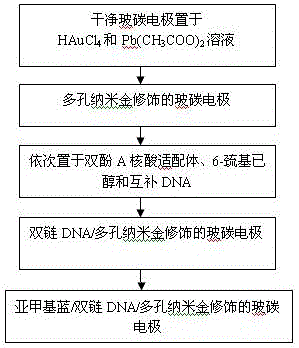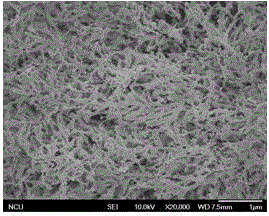Label-free aptamer sensor and method for detecting bisphenol A
A nucleic acid aptamer and detection method technology, applied in the field of chemical sensing and electroanalytical chemical detection, can solve the problems of affecting the binding affinity of aptamers and target molecules, complex labeling process, and high cost
- Summary
- Abstract
- Description
- Claims
- Application Information
AI Technical Summary
Problems solved by technology
Method used
Image
Examples
Embodiment 1
[0025] Preparation of nucleic acid aptamer sensors based on porous gold nanoparticles and methylene blue electrochemical probes, such as figure 1 shown.
[0026] (1) Prepare 0.04mol / L HAuCl 4 and 0.002mol / L of Pb(CH 3 COO) 2 solution, a clean glassy carbon electrode was placed in the above solution, and electrodeposited at a constant potential of -0.2V for 120s to prepare a porous nano-gold modified glassy carbon electrode.
[0027] (2) The porous nano-gold modified electrode was placed in 0.3 μmol / L bisphenol A aptamer for 24 hours, 0.5 mmol / L 6-mercaptohexanol for 80 minutes, and 0.3 μmol / L complementary DNA for 80 minutes to prepare A double-stranded DNA / porous gold nano-modified glassy carbon electrode was obtained.
[0028] (3) Soak the glassy carbon electrode modified with double-stranded DNA / porous gold nanoparticles in 0.1mmol / L methylene blue solution for 25min to obtain the glassy carbon electrode modified with methylene blue / double-stranded DNA / porous gold nanop...
Embodiment 2
[0030] Preparation of nucleic acid aptamer sensors based on porous gold nanoparticles and methylene blue electrochemical probes, such as figure 1 shown.
[0031] (1) Prepare 0.08mol / L HAuCl 4 and 0.004mol / L of Pb(CH 3 COO) 2 solution, a clean glassy carbon electrode was placed in the above solution, and electro-deposited at a constant potential of -0.5V for 70s to prepare a porous nano-gold modified glassy carbon electrode.
[0032] (2) The porous nano-gold modified electrode was placed in 1.0 μmol / L bisphenol A aptamer for 12 hours, 1.0 mmol / L 6-mercaptohexanol for 60 minutes, and 1.0 μmol / L complementary DNA for 60 minutes to prepare A double-stranded DNA / porous gold nano-modified glassy carbon electrode was obtained.
[0033] (3) Soak the glassy carbon electrode modified with double-stranded DNA / porous gold nanoparticles in 0.2mmol / L methylene blue solution for 10min to obtain the glassy carbon electrode modified with methylene blue / double-stranded DNA / porous gold nanop...
Embodiment 3
[0035] Preparation of nucleic acid aptamer sensors based on porous gold nanoparticles and methylene blue electrochemical probes, such as figure 1 shown.
[0036] (1) Prepare 0.12mol / L HAuCl 4 and 0.006mol / L of Pb(CH 3 COO) 2 solution, a clean glassy carbon electrode was placed in the above solution, and electrodeposited at a constant potential at -0.7V for 20s to prepare a porous nano-gold modified glassy carbon electrode.
[0037] (2) Place the porous nano-gold modified electrode in 1.5 μmol / L bisphenol A aptamer for 6 hours, 1.5 mmol / L 6-mercaptohexanol for 20 minutes, and 1.5 μmol / L complementary DNA for 20 minutes to prepare A double-stranded DNA / porous gold nano-modified glassy carbon electrode was obtained.
[0038] (3) Soak the glassy carbon electrode modified with double-stranded DNA / porous gold nanoparticles in 0.4 mmol / L methylene blue solution for 5 minutes to obtain a glassy carbon electrode modified with methylene blue / double-stranded DNA / porous gold nanoparti...
PUM
 Login to View More
Login to View More Abstract
Description
Claims
Application Information
 Login to View More
Login to View More - R&D
- Intellectual Property
- Life Sciences
- Materials
- Tech Scout
- Unparalleled Data Quality
- Higher Quality Content
- 60% Fewer Hallucinations
Browse by: Latest US Patents, China's latest patents, Technical Efficacy Thesaurus, Application Domain, Technology Topic, Popular Technical Reports.
© 2025 PatSnap. All rights reserved.Legal|Privacy policy|Modern Slavery Act Transparency Statement|Sitemap|About US| Contact US: help@patsnap.com



